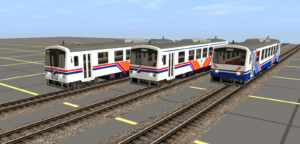
All the necessary dependencies are either included in this package or are avaible on the DLS.
Following the success of the two earlier models, in 1988, Niigata Transys started the production of the MR-100, MR-200 and MR-300 Series trains for the Matsuura Railway, wich was to inherit JNR’s Nishi-Kyushu Line (wich at the time was being provisionally managed by the newly-formed JR Kyushu).
All three serieses were built at the same time and used the same basic 16m bodyshell: the main differences were that the MR-100s were equipped with a gangway to connect with other units, while the MR-200 and MR-300s did not have one. MR-100s and MR-200s were for “regular services”, and as such, had a largely identical livery, while the two MR-300s were cars for “special events”, and as such, carried their own distinctive livery.
A total of 18 cars was made, all in 1988: 11 MR-100s, 5 MR-200s and the two MR-300s, with all units entering in service on the 1st of April 1988, when the Nishi-Kyushu Line was finally handed over to the Matsuura Railway.
With the introduction of the MR-600 Series in 2007, the “original” fleet of MR-100s, MR-200s and MR-300s progressively thinned, with the MR-200s and MR-300s being retired by the end of the year, followed by the MR-100 Series in 2012, with the last unit being retired on the 15th of April.
All the retired units were acquired by the JICA, the Japanese Government’s agency for international cooperation and assistance, and were subsequently donated to the railways of Myanmar in 2009, where all 18 units still run as of today.
